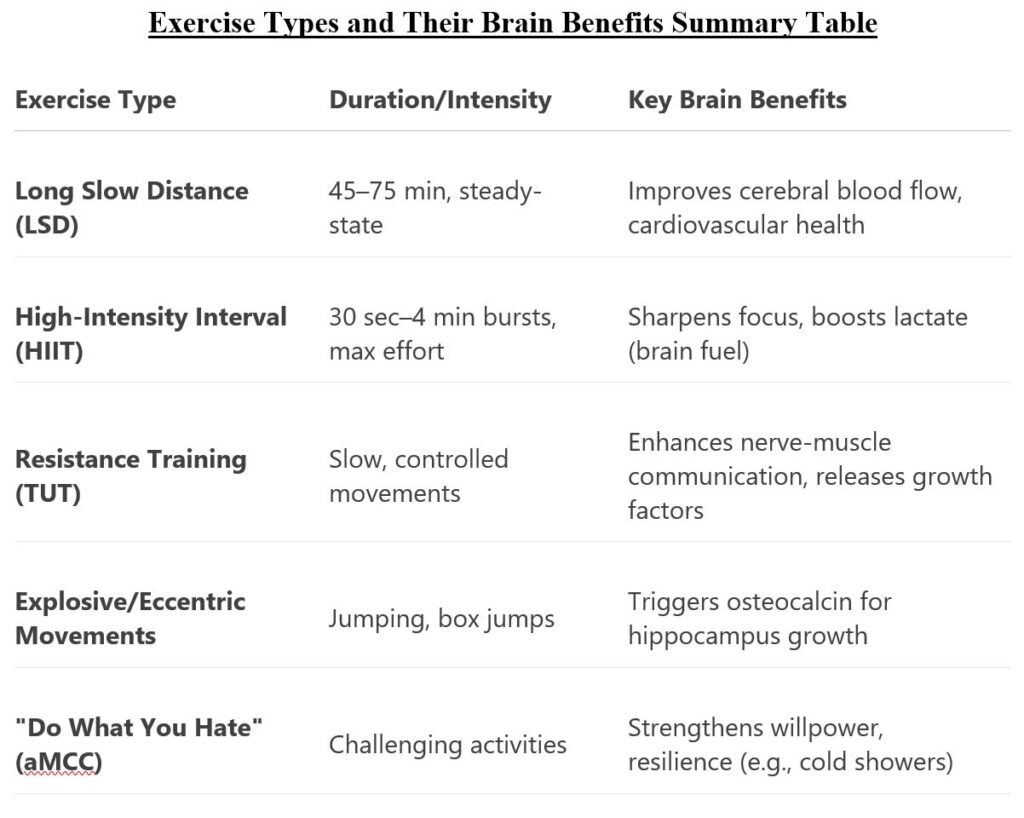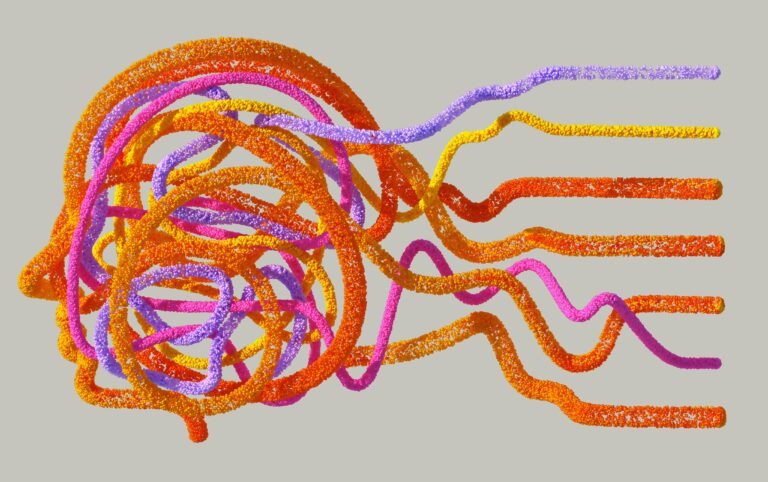How Exercise Boosts Your Brain Health and Performance
Huberman Lab Podcast | May 14, 2025
In today’s fast-paced world, maintaining optimal brain health and cognitive performance is more important than ever. Whether you’re looking to improve memory, focus, or long-term brain function, exercise is one of the most powerful tools at your disposal. In this comprehensive blog post, we’ll dive into the science behind how different forms of exercise can enhance brain health, and provide actionable tips to help you get the most out of your workouts.

The Science of Exercise and Brain Health
Exercise isn’t just about building muscle or losing weight—it’s a brain-boosting powerhouse. Research shows that physical activity can improve brain function both immediately (acute effects) and over time (chronic effects). Here’s how:
1. Arousal and Focus
Exercise increases autonomic arousal, which enhances alertness and focus. This is due to the release of neurotransmitters like dopamine, norepinephrine, and epinephrine, which improve cognitive performance. These chemicals help you stay sharp and focused, making it easier to tackle complex tasks or learn new information.
2. Neuroplasticity
Exercise promotes the release of brain-derived neurotrophic factor (BDNF), a protein that supports the growth and maintenance of neurons. This is crucial for learning, memory, and overall brain plasticity. BDNF helps your brain adapt to new challenges, making it easier to form new neural connections and retain information.
3. Hippocampus Growth
The hippocampus, a brain region critical for memory, benefits significantly from exercise. Activities that load the skeleton, like jumping or resistance training, release osteocalcin, a hormone that supports hippocampal function. Osteocalcin travels from your bones to your brain, where it encourages the growth of new neurons and strengthens existing ones.
4. Blood Flow and Fuel Delivery
Exercise improves cerebral blood flow, delivering more oxygen and nutrients to the brain. This is especially important for maintaining cognitive function as we age. Increased blood flow ensures that your brain has the resources it needs to perform at its best, whether you’re solving a problem or recalling a memory.
Key Types of Exercise for Brain Health
To maximize the brain benefits of exercise, incorporate these four key types of workouts into your routine:
Long, Slow Distance (LSD) Training
- What it is: Steady-state cardio like jogging, swimming, or cycling for 45-75 minutes.
- Why it works: Improves cardiovascular health and cerebral blood flow, which are essential for long-term brain function. This type of exercise is particularly effective at enhancing the health of your blood vessels, ensuring that your brain gets a steady supply of oxygen and nutrients.
High-Intensity Interval Training (HIIT)
- What it is: Short bursts of all-out effort (e.g., 30 seconds to 4 minutes) followed by rest.
- Why it works: Boosts arousal and cognitive flexibility immediately after exercise. It also increases lactate production, which acts as a fuel source for the brain. HIIT is especially effective at improving executive function, which includes skills like problem-solving, planning, and multitasking.
Resistance Training with Time Under Tension (TUT)
- What it is: Slow, controlled movements during weightlifting to maximize muscle engagement.
- Why it works: Enhances nerve-to-muscle communication and releases growth factors that benefit the brain. Resistance training also helps maintain muscle mass, which is important for overall health and mobility as you age.
Explosive and Eccentric Movements
- What it is: Activities like jumping or box jumps that involve quick, powerful movements and controlled landings.
- Why it works: Loads the skeleton, triggering the release of osteocalcin, which supports memory and learning. These movements also improve coordination and balance, reducing the risk of falls and injuries as you age.
The Fifth Element: Do What You Hate
Here’s a surprising tip: Do something you don’t want to do. Engaging in activities that challenge you both physically and mentally activates the anterior mid-cingulate cortex (aMCC), a brain region linked to grit, persistence, and willpower. Studies show that superagers—people who maintain sharp cognitive function into old age—have larger aMCCs.
Why It Works
The anterior mid-cingulate cortex is a brain area that becomes active when you push through challenges. It’s associated with tenacity, grit, and the ability to persevere in the face of difficulty. By engaging in activities you dislike but know are good for you, you can strengthen this brain region and improve your overall cognitive resilience.
Examples
- If you hate running, try a short sprint.
- If you dislike cold showers, incorporate deliberate cold exposure into your routine.
- If you’re not a fan of coordination-based exercises, try rope flow or dance workouts.
The key is to push through discomfort in a safe and controlled way. Over time, you’ll not only improve your physical fitness but also build mental toughness and resilience.

The Role of Sleep in Brain Health
Exercise and sleep are deeply interconnected. Sleep mediates many of the positive effects of exercise on the brain, particularly in terms of memory consolidation and emotional regulation. Here’s how to optimize your sleep:
Exercise Early
High-intensity workouts in the morning can improve deep sleep and REM sleep, both of which are critical for brain health. Deep sleep helps your body recover, while REM sleep is essential for processing emotions and consolidating memories.
Avoid Overtraining
Too much high-intensity exercise can reduce cerebral blood flow and impair cognitive performance. Balance is key. Make sure to include rest days in your routine to allow your body and brain to recover.
Prioritize Sleep Hygiene
- Stick to a Schedule: Go to bed and wake up at the same time every day.
- Create a Relaxing Environment: Keep your bedroom cool, dark, and quiet.
- Limit Screen Time: Avoid screens at least an hour before bed to reduce exposure to blue light.
Practical Tips for Brain-Boosting Exercise
- Start Small: If you’re new to exercise, begin with short sessions and gradually increase intensity and duration.
- Mix It Up: Incorporate a variety of exercises to target different brain pathways.
- Stay Consistent: Even 10 days without exercise can lead to a decline in brain health. Aim for at least 3-4 workouts per week.
- Prioritize Safety: Avoid injuries by choosing exercises that suit your fitness level and using proper form.
The Long-Term Benefits of Exercise for Brain Health
The benefits of exercise extend far beyond the immediate boost in focus and alertness. Over time, regular physical activity can:
- Increase Brain Volume: Exercise has been shown to increase the size of the hippocampus, which is crucial for memory and learning.
- Reduce Cognitive Decline: Regular exercise can slow down age-related cognitive decline and reduce the risk of neurodegenerative diseases like Alzheimer’s.
- Improve Mood: Exercise releases endorphins, which can help reduce symptoms of depression and anxiety.
- Enhance Neuroplasticity: By promoting the growth of new neurons and strengthening existing connections, exercise helps your brain adapt to new challenges and learn more effectively.
How to Get Started
If you’re ready to start reaping the brain benefits of exercise, here’s a simple plan to get you started:
Week 1-2: Build a Foundation
- Cardio: Start with 20-30 minutes of moderate-intensity cardio (e.g., brisk walking, cycling) 3 times per week.
- Strength Training: Incorporate 2 sessions of bodyweight exercises (e.g., squats, push-ups) to build strength.
Week 3-4: Add Variety
- HIIT: Add one HIIT session per week (e.g., 30 seconds of sprinting followed by 1 minute of walking, repeated 5-10 times).
- Resistance Training: Introduce light weights or resistance bands to your strength training routine.
Week 5 and Beyond: Challenge Yourself
- Explosive Movements: Add jumping exercises like box jumps or jump rope to your routine.
- Do What You Hate: Incorporate one activity you dislike but know is good for you (e.g., cold showers, a challenging yoga class).
Final Thoughts
Exercise is one of the most effective ways to enhance brain health, memory, and cognitive performance. By incorporating cardio, HIIT, resistance training, and challenging activities into your routine, you can unlock the full potential of your brain. Remember, the key is consistency and variety.
So, what’s the one exercise you hate but are willing to try for the sake of your brain? Share your thoughts in the comments below!
Related Post




